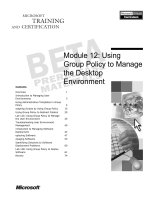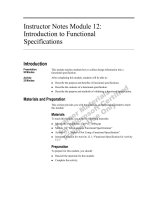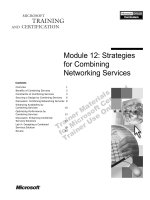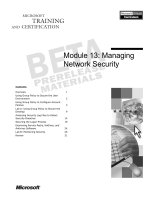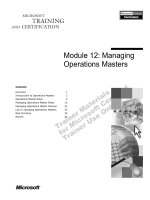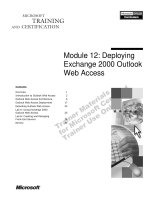Module 12: Managing Operations Masters
Bạn đang xem bản rút gọn của tài liệu. Xem và tải ngay bản đầy đủ của tài liệu tại đây (1.09 MB, 44 trang )
Contents
Overview 1
Introduction to Operations Masters 2
Operations Master Roles 3
Managing Operations Master Roles 12
Managing Operations Master Failures 21
Lab A: Managing Operations Masters 25
Best Practices 35
Review 36
Module 12: Managing
Operations Masters
Information in this document is subject to change without notice. The names of companies,
products, people, characters, and/or data mentioned herein are fictitious and are in no way intended
to represent any real individual, company, product, or event, unless otherwise noted. Complying
with all applicable copyright laws is the responsibility of the user. No part of this document may
be reproduced or transmitted in any form or by any means, electronic or mechanical, for any
purpose, without the express written permission of Microsoft Corporation. If, however, your only
means of access is electronic, permission to print one copy is hereby granted.
Microsoft may have patents, patent applications, trademarks, copyrights, or other intellectual
property rights covering subject matter in this document. Except as expressly provided in any
written license agreement from Microsoft, the furnishing of this document does not give you any
license to these patents, trademarks, copyrights, or other intellectual property.
2000 Microsoft Corporation. All rights reserved.
Microsoft, Active Directory, BackOffice, FrontPage, IntelliMirror, PowerPoint, Visual Basic,
Visual Studio, Win32, Windows, Windows Media, and Windows NT are either registered
trademarks or trademarks of Microsoft Corporation in the U.S.A. and/or other countries.
The names of companies, products, people, characters, and/or data mentioned herein are fictitious
and are in no way intended to represent any real individual, company, product, or event, unless
otherwise noted.
Other product and company names mentioned herein may be the trademarks of their respective
owners.
Project Lead: Mark Johnson
Instructional Designers: Aneetinder Chowdhry (NIIT (USA) Inc.),
Bhaskar Sengupta (NIIT (USA) Inc.)
Lead Program Manager: Paul Adare (FYI TechKnowlogy Services)
Program Manager: Gregory Weber (Volt Computer Services)
Technical Contributors: Jeff Clark, Chris Slemp
Graphic Artist: Julie Stone (Independent Contractor)
Editing Manager: Lynette Skinner
Editor: Jeffrey Gilbert
Copy Editor: Kaarin Dolliver (S&T Consulting)
Testing Leads: Sid Benavente, Keith Cotton
Testing Developer: Greg Stemp (S&T OnSite)
Courseware Test Engineers: Jeff Clark, H. James Toland III
Online Program Manager: Debbi Conger
Online Publications Manager: Arlo Emerson (Aditi)
Online Support: David Myka (S&T Consulting)
Multimedia Development: Kelly Renner (Entex)
Courseware Testing: Data Dimensions, Inc.
Production Support: Irene Barnett (S&T Consulting)
Manufacturing Manager: Rick Terek
Manufacturing Support: Laura King (S&T OnSite)
Lead Product Manager, Development Services: Bo Galford
Lead Product Managers: Gerry Lang, Julie Truax
Group Product Manager: Robert Stewart
Module 12: Managing Operations Masters iii
Instructor Notes
This module provides students with the knowledge and skills to manage
operations masters.
At the end of this module, students will be able to:
!
Define an operations master and describe its importance in an Active
Directory
™
directory service network.
!
Describe the functions of each of the five operations master roles in a forest.
!
Determine, transfer, and seize an operations master role.
!
Describe the effects of, and how to respond to, an operations master failure.
!
Apply best practices for managing an operations master.
In the hands-on lab in this module, students will have the opportunity to
manage operations master roles.
Materials and Preparation
This section provides you with the required materials and preparation tasks that
are needed to teach this module.
Required Materials
To teach this module, you need the following materials:
• Microsoft
®
PowerPoint
®
file 2154A_12.ppt
Preparation Tasks
To prepare for this module, you should:
!
Read all of the materials for this module.
!
Complete the lab.
!
Study the review questions and prepare alternative answers to discuss.
!
Anticipate questions that students may ask. Write out the questions and
provide the answers.
Presentation:
45 Minutes
Lab:
45 Minutes
iv Module 12: Managing Operations Masters
Module Strategy
Use the following strategy to present this module:
!
Introduction to Operations Masters
In this topic, you will introduce operations masters. Explain the use of an
operations master in Active Directory. Emphasize that operations masters
perform updates to the forest that should not be performed as multi-master
updates. Clarify that any domain controller can be an operations master, and
that it is possible to move an operations master role from one domain
controller to another.
!
Operations Master Roles
In this topic, you will introduce the operations master roles. Begin with
introducing the five types of operations master roles and their default
locations in Active Directory. Describe the functions of each of the five
operations master roles: schema master, domain naming master, primary
domain controller (PDC) emulator, relative identifier (RID) master, and
infrastructure master.
!
Managing Operations Master Roles
In this topic, you will introduce managing operations master roles. Begin by
explaining how to determine the holder of an operations master role.
Reinforce that the tool used to determine a specific operations master role is
related to whether the scope of the operations master is domain wide or
forest wide. Next, describe the procedure for transferring an operations
master role. Finally, explain how to seize an operations master role.
Emphasize that the same Active Directory snap-in is used to seize or
transfer an operations master role as is used to determine the role.
!
Managing Operations Master Failures
In this topic, you will introduce managing operations master failures.
Explain how to manage a failure of the PDC emulator and infrastructure
master roles. Emphasize that the loss of the PDC emulator role can affect
the usability of the network, and the administrator should seize the PDC
emulator role if it is known that the current PDC emulator will be
unavailable for a long time. Also, explain how to manage the failure of other
operations master roles.
!
Lab A: Managing Operations Masters
Prepare students for the lab in which they will manage operations master
roles. Tell students that they will work in pairs for this lab. Students will
determine the role of each operations master, transfer an operations master
role from one domain controller to another, and seize an operations master
role from a failed domain controller. They will also use the ntdsutil utility
to manage operations masters. After students have completed the lab, ask
them if they have any questions concerning the lab.
!
Best Practices
Present best practices for managing operations masters. Emphasize the
reason for each best practice.
Module 12: Managing Operations Masters v
Customization Information
This section identifies the lab setup requirements for the module and the
configuration changes that occur on student computers during the labs. This
information is provided to assist you in replicating or customizing Microsoft
Official Curriculum (MOC) courseware.
The labs in this module are also dependent on the classroom
configuration that is specified in the Customization Information section at the
end of the Classroom Setup Guide for course 2154A, Implementing and
Administering Microsoft Windows
®
2000 Directory Services.
Lab Setup
The following list describes the setup requirements for the labs in this module.
Setup Requirement 1
The labs in this module require student computers to be configured as domain
controllers in child domains of nwtraders.msft. There are two student computers
for each child domain. To prepare student computers to meet this requirement,
perform one of the following actions:
!
Complete the labs in module 10, “Creating and Managing Trees and
Forests,” in course 2154A, Implementing and Administering Microsoft
Windows 2000 Directory Services.
!
Run Change.vbs from the C:\Moc\Win2154A\Labfiles\Custom\Autodc
folder.
!
Run Dcpromo.exe on the student computers by using the following
parameters:
• A domain controller for a new domain (first computer only).
• The existing domain tree, which is nwtraders.msft (first computer only).
• A domain controller for the existing domain (second computer only).
• Full DNS domain name, which is domain.nwtraders.msft (where domain
is the assigned domain name).
• NetBIOS domain name, which is DOMAIN.
• Default location for the database, log files, and SYSVOL.
• Permission compatible only with Windows 2000–based servers.
• Directory Services Restore Mode administrator password, which is
password.
Important
vi Module 12: Managing Operations Masters
Setup Requirement 2
The labs in this module require the domain to be in native mode. To prepare
student computers to meet this requirement, perform one of the following
actions:
!
Complete the labs in module 10, “Creating and Managing Trees and
Forests,” in course 2154A, Implementing and Administering Microsoft
Windows 2000 Directory Services.
!
Run Nativesd.vbs from the C:\Moc\Win2154a\Labfiles\Custom\Autodc
folder.
!
Change the domain mode to native in the domain (where domain is your
assigned domain name) Properties dialog box in Active Directory Domains
and Trusts.
Lab Results
Performing the labs in this module introduces the following configuration
changes:
!
The Active Directory Schema snap-in is registered.
!
The infrastructure master and RID master roles are transferred to the second
domain controller in each child domain.
Module 12: Managing Operations Masters 1
Overview
!
Introduction to Operations Masters
!
Operations Master Roles
!
Managing Operations Master Roles
!
Managing Operations Master Failures
!
Best Practices
An operations master is a domain controller that performs a specific role in
Microsoft
®
Windows
®
2000 Active Directory
™
directory service and may
control a specific set of directory changes. For each role, only the domain
controller holding that role can make the associated directory changes. There
are ways to move these roles from one domain controller to another, even if an
operations master fails. Knowing the specific operations master roles that each
domain controller holds in an Active Directory network can help you take
advantage of data replication and network bandwidth.
At the end of this module, you will be able to:
!
Define an operations master, and describe its importance in an Active
Directory network.
!
Describe the functions of each of the five operations master roles in a forest.
!
Determine, transfer, and seize an operations master role.
!
Describe the effects of, and how to respond to, an operations master failure.
!
Apply best practices for managing an operations master.
Slide Objective
To provide an overview of
the module topics and
objectives.
Lead-in
In this module, you will learn
about the types of
operations masters used in
Active Directory and how to
manage them.
2 Module 12: Managing Operations Masters
Introduction to Operations Masters
!
Only a Domain Controller That Holds a Specific Operations Master
Role Can Perform Associated Active Directory Changes
!
Changes Made by an Operations Master Are Replicated to Other
Domain Controllers
!
Any Domain Controller Can Hold an Operations Master Role
!
Operations Master Roles Can Be Moved to Other Domain Controllers
Replication
Single Master Operations
Operations Master
Active Directory supports multi-master replication of directory changes among
all domain controllers in a forest. During multi-master replication, a replication
conflict can potentially occur if concurrent originating updates are performed
on the same data on two different domain controllers.
To avoid these conflicts, some operations are performed in single master (not
permitted to occur at different places in the network at the same time) fashion
by making a single domain controller responsible for the operation. These
operations are grouped together into specific roles within the forest or within a
domain. These roles are called operations master roles. For each operations
master role, only the domain controller holding that role can make the
associated directory changes. The domain controller responsible for a particular
role is called an operations master for that role.
Active Directory stores information about which domain controller holds a
specific role. Clients that can query Active Directory use this information to
contact an operations master when necessary. Any domain controller can
potentially be configured as an operations master. It is possible to move an
operations master role to other domain controllers, even when the current
operations master role holder is unavailable.
Slide Objective
To introduce the use of an
operations master in Active
Directory.
Lead-in
There are situations in
which a single master
update of a forest is
required instead of the usual
multi-master update.
Key Points
Operations masters perform
updates to the forest that
should not be performed as
multi-master updates.
Any domain controller can
be an operations master.
It is possible to move an
operations master role to
other domain controllers.
Module 12: Managing Operations Masters 3
#
##
#
Operations Master Roles
!
Operations Master Default Locations
!
Schema Master
!
Domain Naming Master
!
PDC Emulator
!
RID Master
!
Infrastructure Master
Active Directory defines five operations master roles, each one of which has a
default location. The five operations master roles are:
!
Schema master
!
Domain naming master
!
Primary domain controller (PDC) emulator
!
Relative identifier (RID) master
!
Infrastructure master
The schema master and domain naming master are per-forest roles, meaning
that there is only one schema master and one domain naming master in the
entire forest. The other operations master roles are per-domain roles, meaning
that each domain in the forest has its own PDC emulator, RID master, and
infrastructure master. So, in a forest with only one domain, there are five
operations master roles. In a forest with more than one domain, there are more
than five roles because the per-domain roles need to exist in each domain.
Slide Objective
To introduce the operations
master roles unique to a
domain and a forest.
Lead-in
There are five different
operations master roles.
These roles are unique to
either a domain or a forest.
Emphasize domain wide vs.
forest wide roles.
4 Module 12: Managing Operations Masters
Operations Master Default Locations
First Domain Controller in
the Forest Root Domain
Domain-wide Roles
$
RID master
$
PDC emulator
$
Infrastructure
master
Forest-wide Roles
$
Schema master
$
Domain naming
master
Domain-wide Roles
$
RID master
$
PDC emulator
$
Infrastructure
master
Operations master roles are either forest wide or domain wide.
!
Forest-wide roles are unique for a forest. The schema master and the domain
naming master are forest-wide roles. This means that there is only one
schema master and one domain naming master in the entire forest.
!
Domain-wide roles are unique for each domain in a forest. The PDC
emulator, the RID master, and the infrastructure master are domain-wide
roles. This means that each domain in a forest has its own PDC emulator,
RID master, and infrastructure master.
By default, the first domain controller of a new forest holds all five operations
master roles. The first domain controller for each new domain joining an
existing forest holds the three domain-wide operations master roles for the new
domain.
As the network expands, the operations master placement would be as follows:
!
In a forest with only one domain, there are five operations master roles.
!
In a forest with more than one domain, there are two per-forest operations
master roles. The three per-domain operations master roles are duplicated
for each domain.
Slide Objective
To illustrate the default
locations of Active Directory
operations master role
holders.
Lead-in
There are two forest-wide
operations master roles and
three domain-wide
operations master roles.
Delivery Tips
Use the graphic on the slide
to illustrate the default
locations of forest-wide and
domain-wide operations
master role holders.
Key Points
The first domain controller of
a new forest holds all five
operations master roles and
is also a global catalog
server.
The first domain controller
for each new domain joining
an existing forest holds the
three domain operations
master roles for the new
domain.
Module 12: Managing Operations Masters 5
Schema Master
!
Controls All Updates to the Schema
!
Replicates Updates to All Domain Controllers in the Forest
!
Allows Only the Members of the Schema Admin Group to Make
Modifications to the Schema
Schema Master
Replication
The schema master controls all originating updates to the schema. The schema
contains the master list of object classes and attributes that are used to create all
Active Directory objects, such as computers, users, and printers. The domain
controller that holds the schema master role is the only domain controller that
can perform write operations to the directory schema. These schema updates are
replicated from the schema operations master to all other domain controllers in
the forest. Having only one schema master per forest prevents any conflicts that
would result if two or more domain controllers attempt to concurrently update
the schema. Only the Schema Admin group can make modifications to the
schema.
Slide Objective
To describe the function of
the schema master.
Lead-in
The schema master controls
all updates to the schema.
Key Points
The single forest-wide
schema master performs all
schema modifications,
which are then replicated to
all of the domain controllers
in the forest.
6 Module 12: Managing Operations Masters
Domain Naming Master
!
Controls the Addition or Removal of Domains in
the Forest
New
Domain
Domain Naming
Master
Global Catalog
Server
The domain naming master controls the addition or removal of domains in the
forest. There is only one domain naming master per forest.
When you add a new domain to the forest, only the domain controller holding
the domain naming master role has the right to add the new domain. The
domain naming master manages this process, preventing multiple domains from
joining the forest with the same domain name. When you use the Active
Directory Installation wizard to create a child domain, it contacts the domain
naming master and requests the addition or deletion. The domain naming
master is responsible for ensuring that the domain names are unique. Note that
if the domain naming master is unavailable, you cannot add or remove domains.
The domain controller holding the domain naming master role must also be a
global catalog server. When the domain naming master creates an object that
represents a new domain, it verifies by querying the global catalog server that
no other object, including domain objects, is using the same name as the new
object. Because the domain naming master verifies the name of a new object by
querying the global catalog server, the global catalog must run on the same
domain controller as the one holding the domain naming master role.
Slide Objective
To explain the function of
the domain naming master.
Lead-in
The domain naming
operations master prevents
multiple domains from
joining the forest with the
same domain name.
Key Points
Only the domain controller
that holds the domain
naming master role can add
or remove new domains to
the forest.
The domain naming master
must also be a global
catalog server because the
domain naming master
cannot query a separate
domain controller that runs
as a global catalog server.
Module 12: Managing Operations Masters 7
PDC Emulator
!
Acts As a PDC to Support Windows NT BDCs and
Pre-Windows 2000-based Client Computers
!
Updates Password Changes from
Pre-Windows 2000-based Client Computers
!
Minimizes Replication Latency for Password Changes
for Windows 2000-based Client Computers
!
Manages Time Synchronization
!
Prevents the Possibilities of
Overwriting GPOs
Client Computer Running Pre-Windows
2000 Version of Windows
PDC Emulator
Windows NT
BDC
The PDC emulator acts as a Microsoft Windows NT
®
PDC to support any
backup domain controllers (BDCs) running Windows NT within a mixed-mode
domain. The PDC emulator is the first domain controller that is created in a
new domain.
The PDC emulator performs the following roles:
!
Acts as the PDC for any existing BDCs.
If a domain contains any BDCs or client computers that are running
pre-Windows 2000 versions of Windows, the PDC emulator functions as a
Windows NT PDC. The PDC emulator services client computers and
replicates directory changes to any BDCs running Windows NT.
!
Manages password changes from computers running Windows NT,
Windows 95, or Windows 98, which need to be written to the directory.
!
Minimizes replication latency for password changes.
Replication latency is the time needed for a change made on one domain
controller to be received by another domain controller. When the password
of a client computer running Windows 2000 is changed on a domain
controller, that domain controller immediately forwards the change to the
PDC emulator. If a password was recently changed, that change takes time
to replicate to every domain controller in the domain. If a logon
authentication fails at another domain controller because of a bad password,
that domain controller will forward the authentication request to the PDC
emulator before rejecting the logon attempt.
Slide Objective
To identify the function of
the PDC emulator.
Lead-in
The PDC emulator acts as a
primary domain controller
for computers running
Windows NT.
If appropriate, briefly
describe the function of
Windows NT PDCs and
BDCs.
Key Points
The PDC emulator acts as a
Windows NT PDC in a
mixed-mode domain.
8 Module 12: Managing Operations Masters
!
Synchronizes the time on all domain controllers throughout the domain to
its time.
All domain controllers in the domain get their time synchronized to the
clock of the PDC emulator of that domain. The PDC emulator of the domain
gets its clock set to the PDC emulator’s clock in the forest root domain. The
forest root domain’s PDC emulator should be configured to synchronize
with an external time source. The end result is that the time kept by the
clocks of all Windows 2000-based computers in the entire forest is within
seconds of each other.
Only when the domain is in mixed mode does the domain controller that
holds the PDC emulator role synchronize with BDCs running Windows NT
versions 4.0 or 3.51.
!
Prevents the possibilities of overwriting Group Policy objects (GPOs).
The Group Policy snap-in, by default, runs on the domain controller that
holds the PDC emulator role for that domain. This is done to reduce the
potential for replication conflicts. It is not a requirement, however that a
Group Policy object (GPO) be updated on this domain controller.
Note
Module 12: Managing Operations Masters 9
RID Master
Move
!
Allocates Blocks of RIDs to Each
Domain Controller in Its Domain
!
Prevents Object Duplication if Objects
Move from One Domain Controller to
Another
Object SID = Domain SID + RID
Object SID = Domain SID + RID
RID Master
Block of RIDs
Block of RIDs
Move
RID Allocation
The relative identifier (RID) master allocates blocks of RIDs to each domain
controller in the domain. Whenever a domain controller creates a new security
principal, such as a user, group, or computer object, it assigns the object a
unique security identifier (SID). This SID consists of a domain SID, which is
the same for all security principals created in the domain, and a RID, which is
unique for each security principal created in the domain.
The RID master supports creating and moving objects as follows:
!
Creating Objects. To allow a multi-master operation to create objects on
any domain, the RID master allocates a block of RIDs to a domain
controller. When a domain controller needs an additional block of RIDs, it
initiates communication with the RID master. The RID master allocates a
new block of RIDs to the domain controller, which the domain controller
assigns to the new objects.
The process of creating the objects and communicating to the RID master
for additional blocks of RIDs can be repeated as many times as necessary. If
a domain controller’s RID pool is empty, and the RID master is unavailable,
new security principals cannot be created on that domain controller. You
can view the RID pool allocation by using the dcdiag utility.
!
Moving Objects. When you move an object between domains, you must
initiate the move on the RID master that currently contains the object. This
prevents the possible duplication of objects. If an object were moved, but
there were no single master that kept this information, then it would be
possible to move the object to multiple domains without realizing that a
previous move had already taken place.
The RID master deletes the object from the domain when the object is
moved from that domain to another domain.
Slide Objective
To explain the functions of
the RID master.
Lead-in
The RID master ensures
that all domain SIDs are
unique by allocating blocks
of RIDs to domain
controllers when they need
them.
Key Points
The RID is unique for each
object.
The RID master manages
the RID creation when an
object is created or moved.
10 Module 12: Managing Operations Masters
Infrastructure Master
!
Updates References to Objects and Group
Memberships from Other Domains
Infrastructure
Master
Global Group Nested
into Domain Local Group
Move
GUID
SID
New DN
GUID
SID
New DN
Group
Membership List
Group
Membership List
The infrastructure master is used to update object references in its domain that
point to the object in another domain. The object reference contains the object’s
globally unique identifier (GUID), distinguished name and possibly a SID. The
distinguished name and SID on the object reference are periodically updated to
reflect changes made to the actual object. These changes include moves within
and between domains as well as the deletion of the object.
Group Membership Identification
If SID or distinguished name modifications to user accounts and groups are
made in other domains, the group membership for a group on your domain that
references the changed user or group needs to be updated. The infrastructure
master for the domain in which the group (or reference) resides is responsible
for this update; it distributes the update through normal replication throughout
its domain.
The infrastructure master updates object identification, by the following rules:
!
If the object moves at all, its distinguished name will change because the
distinguished name represents its exact location in the directory.
!
If the object is moved within the domain, its SID remains the same.
!
If the object is moved to another domain, the SID changes to incorporate the
new domain SID.
!
The GUID does not change regardless of location (the GUID is unique
across domains).
In a single domain forest, the infrastructure master does not need to
function because there are no external object references for it to update.
Slide Objective
To illustrate the function of
the infrastructure master.
Lead-in
The infrastructure master is
responsible for updating
group membership data for
groups that have members
that move between two or
more domains.
Key Points
The infrastructure master is
responsible for updating the
external references to an
object whenever the object
changes.
The infrastructure master
compares its data with that
of a global catalog server.
The infrastructure master
should not be the same
computer that hosts a global
catalog in a multiple domain
forest.
Note
Module 12: Managing Operations Masters 11
Infrastructure Master and the Global Catalog
The infrastructure operations master should not be the same domain controller
that hosts the global catalog. If the infrastructure master and the global catalog
are the same computer, the infrastructure master will not function because it
does not contain any references to objects that it does not hold. In this case, the
domain replica data and the global catalog server data cannot exist on the same
domain controller.
The infrastructure master for a domain periodically examines the references,
within its replica of the directory data, to objects not held on that domain
controller. It queries a global catalog server for current information about the
distinguished name and SID of each referenced object. If this information has
changed, the infrastructure master makes the change in its local replica. These
changes are replicated using normal replication to the other domain controllers
within the domain.
